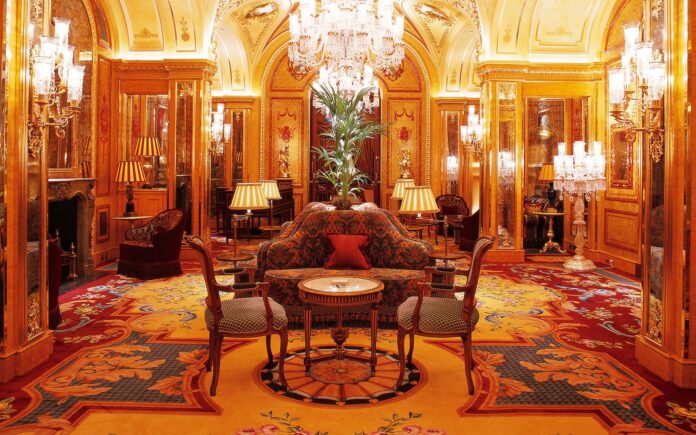The Amber Room is a masterpiece of early 18th-century European art, gifted by King Frederick Wilhelm I of Prussia to Peter I of Russia. The room’s decor included mosaic panels made from amber with relief decorations. Tiny landscapes and scenes were engraved on the reverse side of the natural stone, visible through its thickness.
Between 1743 and 1746, the decor was enhanced with new details and installed in the grand interior of the Winter Palace. By 1770, thanks to the efforts of a team of craftsmen, the room was transformed into the Amber Room of the Catherine Palace in Tsarskoye Selo (now Pushkin).
History of Creation
The reign of Prussian King Frederick I (1701–1713) began with a major reconstruction of Berlin, especially the monarch’s residences. Originally, the amber-paneled room was intended for the queen’s country residence at Lietzenburg. Danish craftsman Gottfried Wolfram was brought to the capital for the stonework, later continued by Danzig masters Gottfried Turau and Ernst Schacht.
In 1709, two years after his wife’s death, Frederick decided to decorate the 30-meter gallery of the Oranienburg Palace with amber panels. However, the project was not completed before his death, so the panels were moved to the capital and stored in the castle. In 1716, the Amber Room was presented to Russian Emperor Peter I as a gift from the new Prussian king.
Fate of the Collection in Russia
The decorations arrived in St. Petersburg in 18 crates of various sizes. However, upon assembly, many details were found to be missing, and the panels ended up in the wing of the Summer Palace. They remained there until 1743 when Empress Elizabeth Petrovna commissioned court architect Bartolomeo Francesco Rastrelli to use the Amber Room’s details to decorate a hall in the Winter Palace.
To create a unified composition, the architect used mirrored pilasters in gilded frames. Door reveals, cornices, and moldings were carved from wood and painted “to resemble amber.” Restoration of damaged fragments was overseen by the Italian master A. Martelli. The palace underwent frequent renovations, and the room’s location changed several times.
The Amber Room
In the mid-century, Rastrelli was commissioned to create the Amber Room in the Catherine Palace in Tsarskoye Selo, the summer residence of the Romanov dynasty. For the 96 m³ room, the architect used a three-tiered division.
On the middle level, large panels were placed with oval and rectangular relief frames. Four of these frames contained Florentine mosaics depicting allegories of the five human senses. The panels were separated by double pilasters with bronze sconces. The narrow spaces between them were filled with flat amber mosaics. The same pattern was used for the horizontal panels on the lower row. Where amber was missing, the walls were covered with canvas and painted over. The upper tier (frieze) was decorated with “amber-like” painting and adorned with ornaments, sculptures, and lighting.
The decor covered three walls of the room, with windows installed in two rows on the fourth wall. The central place on the ceiling was reserved for an allegorical depiction of Wisdom guarding Youth from the temptations of love. The doors were adorned with intricate gilded carvings. Later, a parquet floor made of expensive wood was installed in the hall.
A curator was responsible for the preservation of the artwork. In the mid-century, this position was held by Prussian master Friedrich Roggenbuck, associated with the final stage of the Amber Room’s creation.
In 1763, Catherine II issued a decree to replace the painted decorations with mosaic amber panels, resulting in the use of 450 kg of high-quality amber. Ancient amber masks, framed with carved fruit garlands, were placed at the top of each large panel.
Most of the decorative elements were made in the Amber Workshop, also led by Roggenbuck. The interior was complemented by elegant items and furniture—gilded bronze candelabra clocks, wooden commodes, Chinese porcelain vases, and glass vitrines housing a collection of amber items. In the southern corner was a wooden table designed by Rastrelli with a single leg.
In subsequent years, the room only underwent restorations. The most expensive of these took place from 1830 to 1833, costing over 70,000 rubles for the restoration of the amber panels. Another restoration was planned for the summer of 1941, but the onset of war disrupted these plans.
The Amber Room During the War
Some amber artifacts were evacuated in the early months of the war, and it was decided to conserve the wall panels—covering the room with paper and then sealing it with gauze and cotton wool. After the arrival of the Germans, the panels were dismantled and sent to the Königsberg Castle, which housed a museum of amber. In the spring of 1945, during the assault on the city’s fortifications by Soviet troops, the Amber Room vanished without a trace.
The Mystery of the Disappearance
Efforts to locate the masterpiece have continued for over 70 years—searches have been conducted in underground bunkers in Kaliningrad, Poland, and Germany. In 2015, treasure hunters in the vicinity of the Polish castle of Książ uncovered a convoy of Nazi gold, but no traces of amber were found.
The only country where the search for fragments of the room has been successful is Germany. In 1997, one of the four Florentine mosaics stolen during the evacuation from Königsberg was found in Bremen. Three years later, this valuable artifact was returned to Russia. Another returned item from Germany was a unique amber commode.
Restoration work on the Amber Room of the Catherine Palace began in 1981 and was completed in 2003 in time for the 300th anniversary of St. Petersburg.
